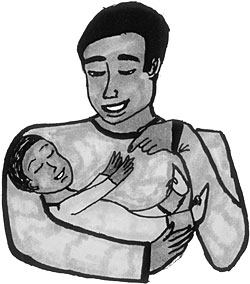Standing in Your Child’s Shoes
How to meet your child’s needs during visits.
| |
 |
| Illustration by Ogen Dolma |
Visit Coaching supports parents in planning fun visits that help them bond with their children. Here Marty Beyer, who developed Visit Coaching, explains how parents can make the most of family time while their children are in foster care:
One of the most important things for a parent to do during visits is to stand in the child’s shoes. Imagine what it’s like for your child to be separated from you and to come to the visit, whether they’re 2 years old or they’re 12 years old. Standing in their shoes, try to imagine: What does my child want from me during our family time?
My child needs me to be fully welcoming. My child needs my full attention in the visit. My child needs praise. Each of my children needs a little “just you, just me” time when we are together. My child needs reassurance. My child needs me to talk about the next time we will see each other. My child needs a good ending to the visit.
It’s often harder to see emotional needs than physical needs. We know to change a wet diaper or to feed our children. But these emotional needs are just as important as feeding a sandwich to your hungry kid.
Confusing Feelings
At times, it can be difficult to understand the child’s needs. A child might run to a toy as soon as she enters the visit room and not say hello to the parent. Some foster parents or caseworkers might assume that past abuse has made the child afraid of the parent. Actually, it might just be that the child is full of confused feelings during the visit.
Unfortunately, children usually can’t explain their feelings. A child won’t walk in and say, “I’m feeling really confused. Why am I living with someone else and visiting you in an office?” Instead the child might just walk over and start playing with a toy without saying hello. Most children behave their feelings and can’t explain them in words.
Unless someone has told the parent in advance that it is fairly common for children to act this way during visits, many parents feel rejected. They might feel disappointed and angry with the child, or believe that the foster parent has set the child against them. That can set the visit off to a bad beginning.
Parents who understand their children’s complicated feelings are more able to meet their needs. Parents can say to themselves, “I will go to my child and get on the floor and play even though my child hasn’t said hello.”
Supporting the Parent
Parents can also request a Visit Coach to help them plan their visits and talk through challenges they might face. The Visit Coach’s main role is to ask parents: “What does your child want from you?”
At first, parents often say, “My child wants to go home.” But that’s the one need that the parent can’t meet. Coaches help parents stand in the child’s shoes and think, “What are the child’s needs that I can meet?”
Parents might start with physical needs, like being hungry and needing food, or basic emotional needs, like, “My children need to know that I love them.” The Coach’s role is to ask, “Well, what would make your child feel that you love them? What are the fun things that you did with your child before placement?”
Making a Connection
Coaches can also help parents think about developmental needs. If a child is developing speech, the child needs to practice talking during visits. If the child is in elementary school, the child needs to tell the parent about friends and what they’re doing in school.
The most important thing during visits is to get a back-and-forth going with your children, whether that’s through singing a song, giving raspberries on the belly during the diaper change, smiling at each other, playing a game, or talking about school. With little kids, you might push cars around on the floor. Taking pictures, doing art, and even painting fingernails can be a time to listen to your child talk about their lives and a way to make that special connection.
Focus on Bonding
Visit Coaches can also help parents avoid one of the most common mistakes: using the visit time to talk with agency workers about their case. Parents do this because they feel that the top priority is to communicate with someone who can help with their case. But when parents use visits to talk with other adults, caseworkers worry that the parent is not interested in the child.
It’s very sad for parents to think, “My child needs me to work hard to build our relationship while my child is in foster care.” That’s painful because no one wants to believe that a child’s connection to her parent is fragile. But a few weeks or months is a long time for a child to be apart from a parent. A child’s attachment to the parent is like a flower—you have to water it regularly and give it sun.
(back to top)

